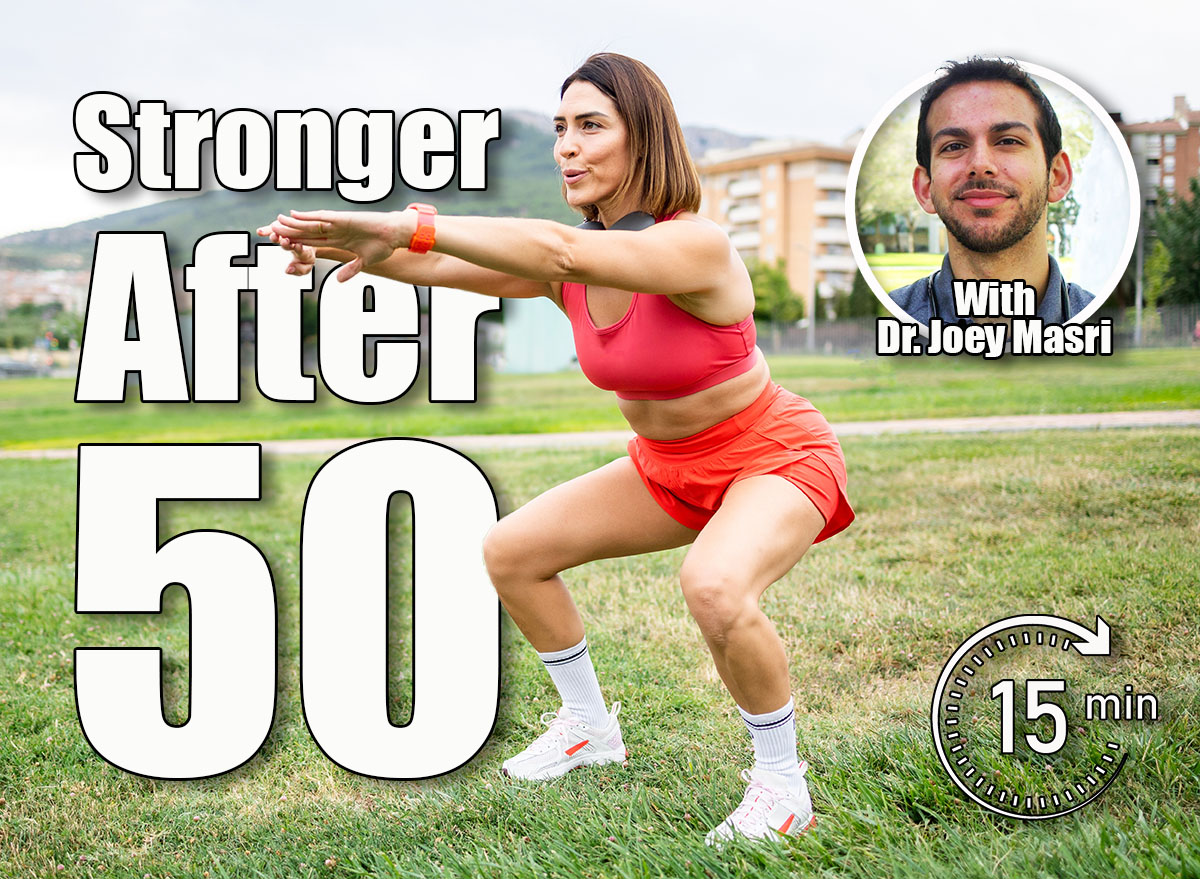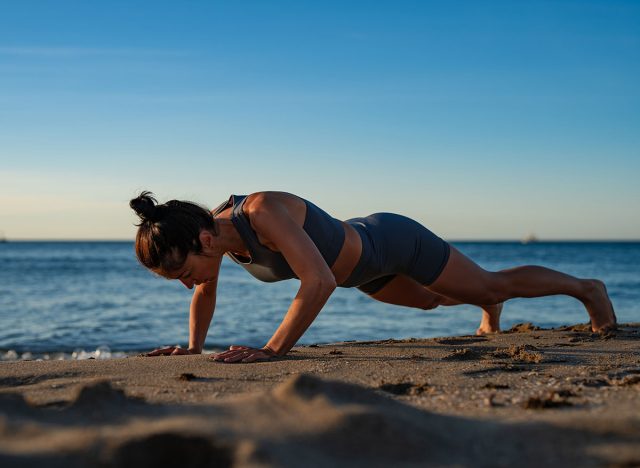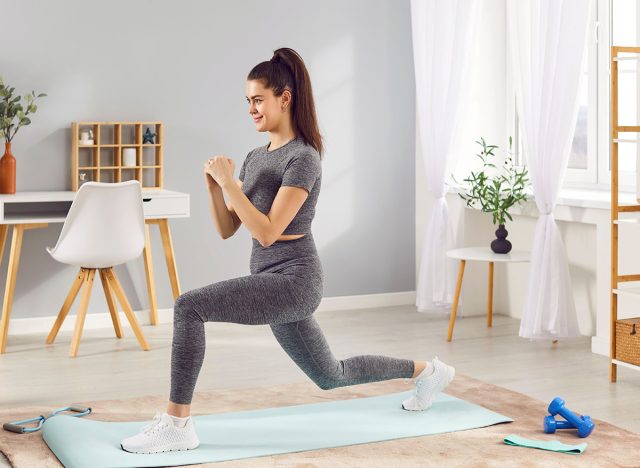7 Simple Bodyweight Exercises That Keep You Stronger Than Most 30-Year-Olds After 50

Preserving total-body strength after 50 is essential for maintaining bone density, muscle mass, balance, power, and independence. According to Life Time personal trainer and author of “Lift for Life: A practical, evidence-based guide to training,” Joe Meier, incorporating pain-free, full range of motion strength training into your routine is an excellent way to achieve these goals. To help you out, experts outline seven simple bodyweight exercises that will help keep you strong and fit after 50.
“After a person turns 40, life can get even busier with kids, careers, and travel, so focusing on at least maintaining a certain level of fitness and strength is crucial to set yourself up for success in your 50s, 60s and beyond,” Meier tells us. “Bodyweight exercises, if you don’t have or prefer using gym equipment or free weights, can be a sufficiently challenging way to resistance train to maintain or improve your function as you age. The examples below are good options that can be progressed or regressed based on your fitness level.”
Dr. Joey Masri of Vice City Sports Medicine, says strength is “the foundation of independence, mobility, and longevity.” Strong muscles decrease your risk of falling, protect the joints, and make performing simple daily tasks a breeze.
“Without consistent training, declines in strength can accelerate after 50, leading to loss of function and a reduced quality of life,” Masri tells us. “Being strong simply makes all aspects of life easier.”
7 Bodyweight Exercises That Keep You Strong After 50
“It is important to note that bodyweight training builds the foundation, but that’s just the start,” Masri points out. “To keep improving strength, bone density, and ability, you need progressive overload by gradually increasing resistance with bands, dumbbells, or weights. The most effective path is to start with bodyweight exercises, build consistency over time, and then progress to resistance training to keep getting stronger as you age.”
Masri stresses that everyone’s strength and fitness level is different. It’s important to get evaluated by a physician or physical therapist to determine your fitness baseline.
Weave these exercises into your routine two to three times a week at an intensity that best suits your fitness level. Meier notes that consistency “is the most important factor in a fitness routine.”
Pushups

- Start with a high plank with hands under your shoulders and your body straight.
- Bend your elbows and lower your chest toward the floor.
- Maintain a long, straight body as you lower.
- Exhale as you press back up, straightening your arms.
- Perform 2 to 3 sets of 12 reps.
- To regress the exercise, place your hands on a workout bench, counter, or wall. To progress, lower your body slower, increase the range of motion by allowing your chest to touch the ground, or add a pause at the bottom.
Lunges

- Stand tall, feet parallel, hip-distance apart.
- Place your hands on your hips.
- Step forward with one foot.
- Engage your core as you bend your knees, lowering to form 90-degree bends in both legs.
- Keep your upper body straight.
- Press through your front heel and the ball of your back foot to rise back up.
- Complete 2 to 4 sets of ~10 to 15 reps.
- To regress the exercise, hold onto something for balance or decrease the range of motion. To progress, stand on one leg and balance in between reps, bump up the speed of your reps, or increase the depth at the bottom of the lunge.
Jump Squats
- Stand tall, feet shoulder-width apart.
- Lower into a squat.
- Press through your heels to explode up into a jump, reaching your arms overhead.
- Lower softly on the balls of your feet, bringing your arms back down.
- Complete 2 to 4 sets of ~10 to 15 reps.
- To regress the exercise, perform squats as quickly as possible without lifting your feet off the ground. To progress, add reps over time or increase the effort with each rep. Complete 2 to 4 sets of 3 to 6 reps for a power exercise like this.
RELATED: Over 45? If You Can Hold These 3 Positions, You’re Stronger Than Most
Glute Bridge
- Lie flat on your back with bent knees and feet hip-width apart on the floor.
- Press through your heels to lift your hips until your body forms a straight line from head to heels.
- Squeeze your buttocks, holding at the top for a moment.
- Lower your hips back to the start position.
- Complete 2 to 4 sets of ~10 to 15 reps.
- To progress the exercise, perform a single-leg glute bridge or hip thrust, or hold at the top.
Pull-ups
- Stand tall and grab onto a pull-up bar using an overhand grip, hands shoulder-distance apart.
- Hang onto the bar with fully extended arms.
- Pull your chest up toward the bar by bringing your elbows down and back.
- Slowly lower back to the start position.
- Complete 2 to 4 sets of ~10 to 15 reps.
- To regress, perform a suspension inverted row with your body more perpendicular to the floor. To progress, increase the rep count or pause at the top of the movement.
Plank With Leg Raise
- Assume a high plank/pushup position with hands under your shoulders and body in a straight line.
- Lift one foot without allowing your hips to shift to the side or lift.
- Hold for 2 seconds.
- Switch sides.
- Complete 2 to 4 sets of ~10 to 15 reps.
- To regress, place your hands or feet closer together. To progress, place your hands or feet further apart.
Sit-to-Stand
- Begin seated, crossed-legged on the ground.
- Try to stand up without using your knees, hands, or additional support.
- Perform 2 to 3 sets of 15 reps.